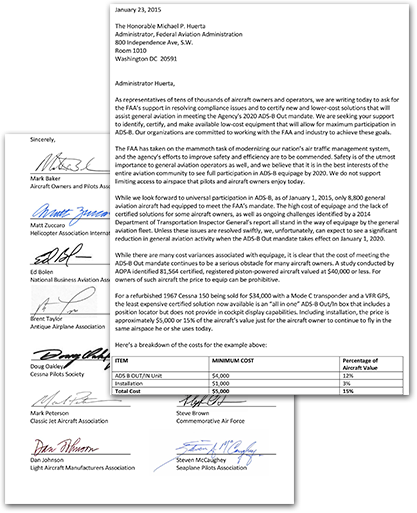
The general aviation community has banded together to urge the Federal Aviation Administration (FAA) to address critical barriers to ADS-B (Automatic Dependent Surveillance—Broadcast) equipage, including high cost and lack of certified solutions for some types of aircraft.
In a joint letter sent to FAA Administrator Michael Huerta on Jan. 23, 14, general aviation groups representing tens of thousands of aircraft owners asked the FAA to take aggressive steps that would allow more aircraft to meet the agency’s mandate to equip for ADS-B Out by 2020.
“We hear every day from members who want to meet the FAA’s mandate but can’t, often because they can’t afford it or because there is simply no path to compliance,” said Mark Baker, president of the Aircraft Owners and Pilots Association (AOPA). “Too many of these pilots tell me they’ll be doing a lot less flying if we can’t find workable, affordable solutions before the mandate takes effect.”
ADS-B is a cornerstone of the FAA’s effort to modernize the air traffic system. ADS-B Out uses specialized GPS equipment installed in each aircraft to identify the aircraft’s location and automatically report it to ground stations and other aircraft. ADS-B In, which is not part of the FAA’s mandate, provides that information along with other data to participating aircraft, allowing them to use an in-cockpit display to “see” nearby traffic and weather.
The groups emphasized their support for universal participation in ADS-B, but pointed out that significant hurdles to compliance remain.
“The high cost of equipage and the lack of certified solutions for some aircraft owners, as well as ongoing challenges identified by a 2014 Department of Transportation Inspector General’s report, all stand in the way of equipage by the general aviation fleet,” the letter said. “Unless these issues are resolved swiftly, we, unfortunately, can expect to see a significant reduction in general aviation activity when the ADS-B Out mandate takes effect on January 1, 2020.”
While the FAA has identified cost as a barrier to equipage, aviation organizations want the agency to work quickly to begin certifying lower-cost solutions that could serve large segments of the general aviation community.
The groups asked the FAA to “make working with equipment manufacturers and our organizations its highest priority in order to meet this mandate on general aviation.”
Failure to do so, the letter warned, could limit participation in ADS-B, prevent the full realization of safety benefits, reduce general aviation activity and create economic hardships.
As of Jan. 1, 2015, only about 8,800 general aviation aircraft had equipped to meet the mandate.
Using a 1967 Cessna 150 valued at $34,000 as an example, the letter noted that even the least expensive path to compliance would require the owner to spend approximately $5,000, or 15 percent of the aircraft’s value, simply to continue operating in the same airspace he or she uses today. The owners of more than 81,000 registered aircraft valued at $40,000 or less face a similar dilemma.
“That’s why we ask the FAA to be an active partner and commit its Flight Standards and Technical Operations team to work with stakeholders in identifying cost drivers in the current ADS-B Out technical standards and develop alternative solutions that leverage technology to drive down these cost barriers,” the letter said.
For some other types of aircraft, including experimental aircraft, no path to compliance currently exists.
“ADS-B compliance requires a supplemental type certificate or new type certificate for the aircraft where it will be installed,” the letter explained.” But since experimental aircraft, by definition, are one of a kind and do not have type certificates, no supplemental type certificate can be issued.”
Similar issues exist for factory-built Light Sport Aircraft, new glass-panel aircraft and some Part 25 aircraft, leaving thousands of owners with no way to comply with the mandate.
The letter also cited concerns about the potential for decreased activity at 1,339 airports located under or within what will be ADS-B-ruled airspace. Fewer operations could have significant negative economic impacts for the airports as well as for the businesses and communities they serve.
Finally, the letter noted that gaps in coverage, technical and training issues, data integrity concerns, cost overruns, delays and other issues identified by a 2014 Department of Transportation Inspector General’s report must be addressed for ADS-B to deliver on its promises.
The letter was signed by the leaders of the Aircraft Owners and Pilots Association, American Bonanza Society, Antique Aircraft Association, Cardinal Flyers, Cessna Pilots Society, Citation Jet Pilots Owner Pilot Association, Classic Jet Aircraft Association, Commemorative Air Force, Experimental Aircraft Association, Helicopter Association International, Light Aircraft Manufacturers Association, National Air Transportation Association, National Business Aviation Association, and Seaplane Pilots Association.
